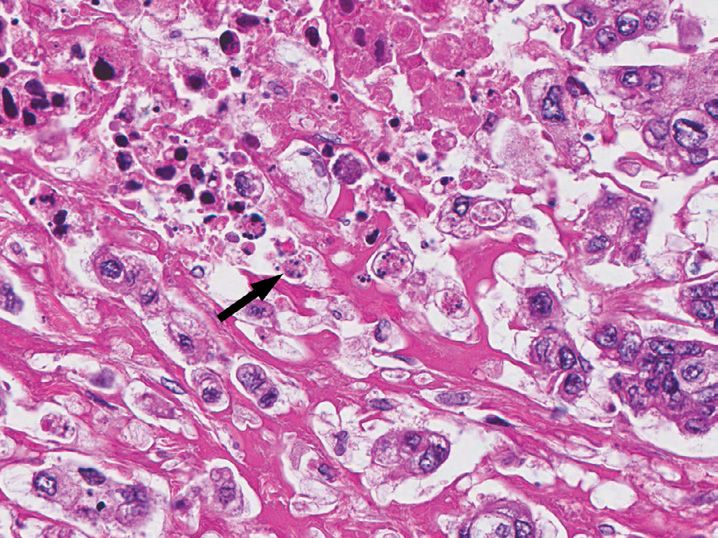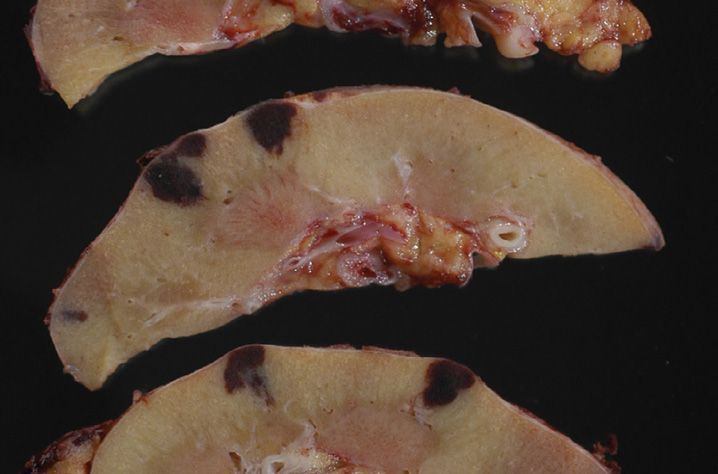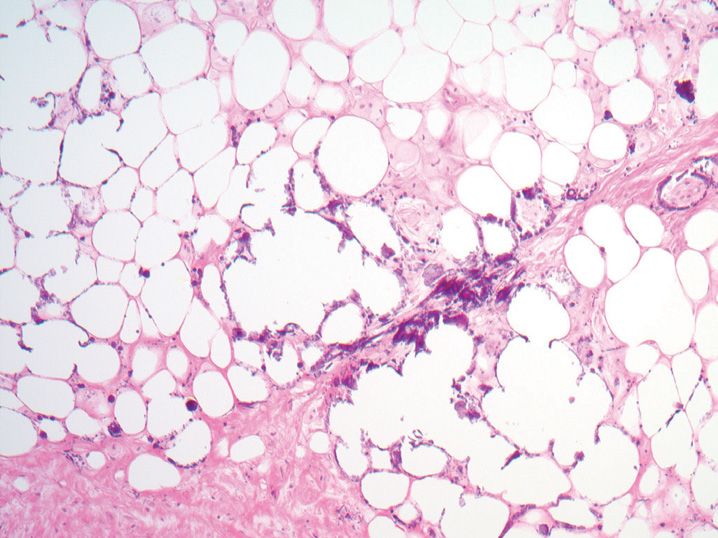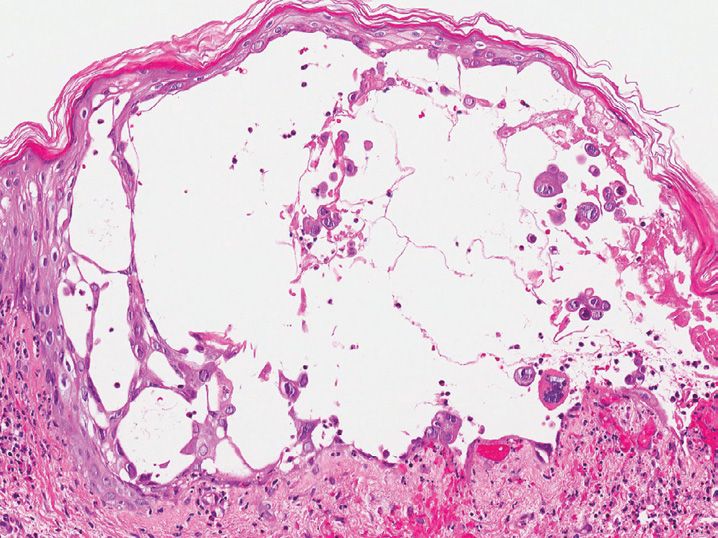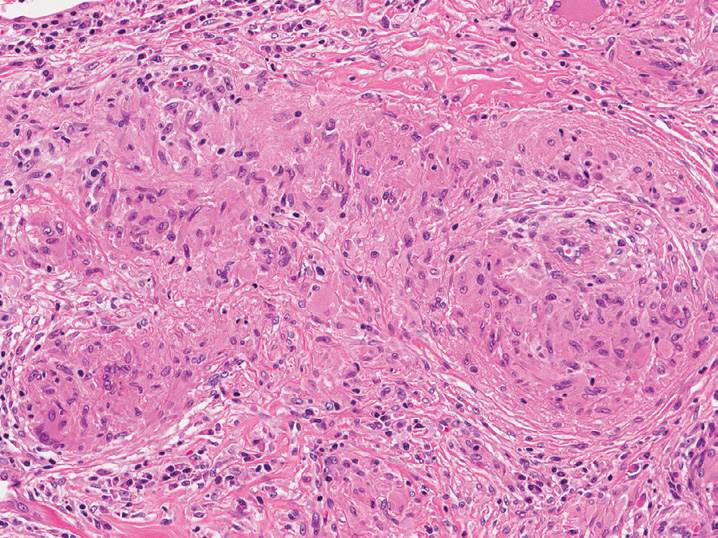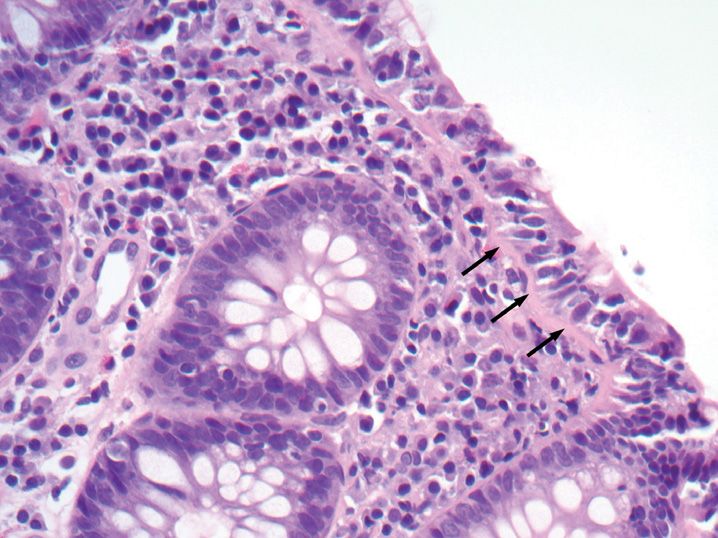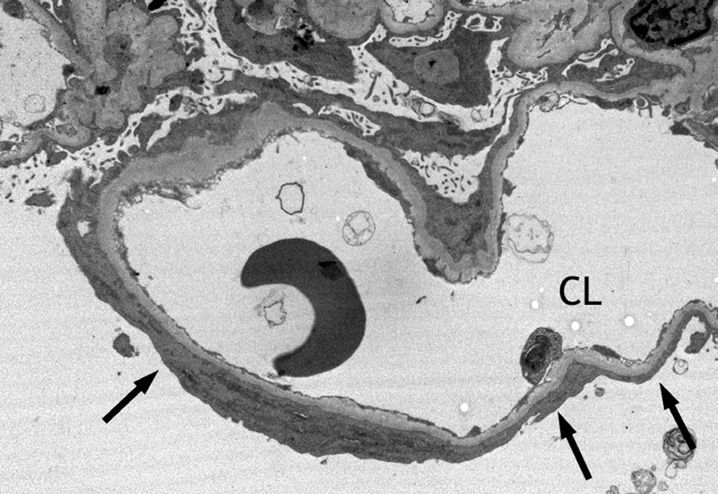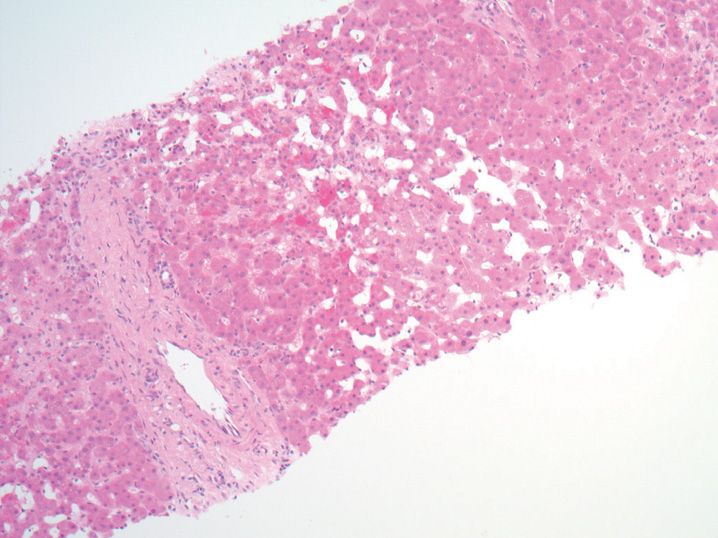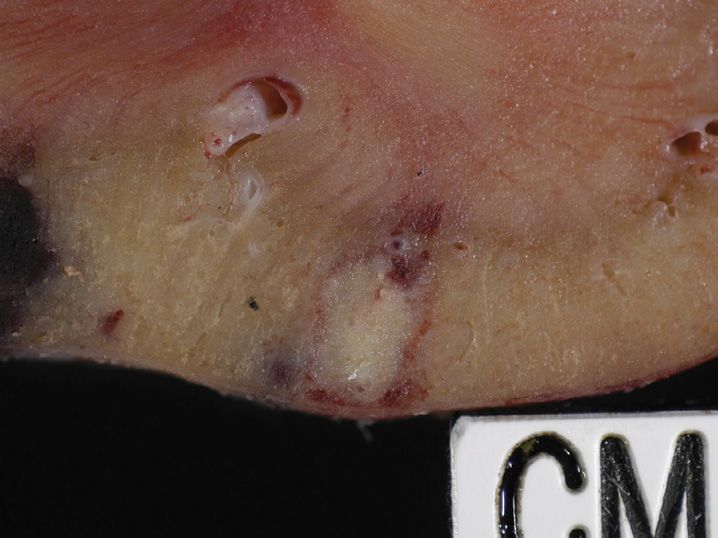FIGURE 1-1
(A) Bilirubin
(B) Calcium
(C) Iron
(D) Lipofuscin
(E) Melanin
2. Cells with irreversible injury undergoing cell death can show nuclear shrinkage, basophilia, and nuclear fragmentation (see Figure 1-2 cell at arrow). This process is called
(A) Balloon degeneration
(B) Fatty change
(C) Karyolysis
(D) Karyorrhexis
(E) Pyknosis
3. An atherosclerotic plaque ruptures and obstructs blood flow to a segment of kidney (see Figure 1-3). At 6 hours after the event, the involved kidney would show what pattern of necrosis on microscopic examination?
(A) Caseous necrosis
(B) Coagulative necrosis
(C) Fibrinoid necrosis
(D) Gangrenous necrosis
(E) Liquefactive necrosis
4. A patient with renal failure on long-term dialysis and taking aluminum-based antacids presents with multiple lesions in the kidneys, lungs, and skin. A biopsy was performed (see Figure 1-4). This is an example of
(A) Dystrophic calcification
(B) Fat necrosis
(C) Heterotopic bone formation
(D) Metastatic calcification
(E) Metastatic carcinoma
5. The changes present in this skin biopsy (see Figure 1-5) are an example of which morphologic pattern of acute inflammation?
(A) Abscess formation
(B) Fibrinous inflammation
(C) Serous inflammation
(D) Suppurative inflammation
(E) Ulcer formation
6. This pattern of inflammation (see Figure 1-6) is associated with which of the following diseases?
(B) Nonspecific interstitial pneumonia
(C) Sarcoidosis
(D) Staphylococcus aureus
(E) Varicella virus
7. The thick pink material at the arrows in this photomicrograph (see Figure 1-7) is predominantly composed of what extracellular matrix protein?
(A) Collagen type II
(B) Collagen type IV
(C) Elastin
(D) Fibrillin
(E) Hyaluronan
8. After a woman has her ear pierced, a keloid developed at the site of the piercing, which was subsequently excised (see Figure 1-8). Which of the following is incorrect about this abnormal repair response?
(A) Due to exuberant granulation tissue growth
(B) Fails to regress with normal remodeling
(C) May grow beyond the boundaries of the original wound
(D) Most common in African Americans
(E) Traumatic injury to the deep dermis is a typical inciting event
9. A patient with kidney disease (see Figure 1-9 electron micrograph of a typical glomerulus from this patient, CL = capillary lumen) and nephrotic syndrome has severe pitting edema in his lower legs. This edema is primarily caused by which of the following processes?
(A) Increased hydrostatic pressure due to arteriolar dilatation
(B) Increased hydrostatic pressure due to impaired venous return
(C) Increased vascular permeability
(D) Reduced plasma osmotic pressure
(E) Sodium retention
10. All of the following are examples of tissue hypertrophy except
(A) Biceps enlargement due to exercise
(B) Endometrial thickening due to excess estrogen
(C) Left ventricle enlargement due to high blood pressure
(D) Right ventricle enlargement due to pulmonary fibrosis
(E) Uterine enlargement during pregnancy
11. All of the following are examples of metaplasia except
(A) Apocrine change in the breast
(B) Barrett’s esophagus
(C) Bronchial squamous mucosa in a smoker
(D) Myositis ossificans
(E) Notochord loss with development of the spinal cord
12. All of the following are true regarding ischemia except
(A) Accumulation of toxic metabolites contributes to cell injury
(B) Anaerobic glycolysis continues after the insult
(C) Can be caused by reduced venous drainage
(D) More rapid and severe than hypoxia alone
(E) Most commonly due to blockage of arterial blood supply
13. Reversible cell injury is characterized by which of the following changes?
(A) Apoptosis
(B) Cell membrane disruption
(C) Cellular swelling
(D) Loss of mitochondrial function
(E) Karyorrhexis
14. Which of the following situations would most likely result in liquefactive necrosis?
(A) Acute pancreatitis
(B) Pulmonary embolism
(C) Pulmonary tuberculosis
(D) Myocardial infarction
(E) Stroke
15. A severely burned patient requires very high fluid replacement due to insensible losses from increased vascular permeability. All of the following are causes of increased vascular permeability and exudates in an inflammatory reaction except
(A) Endothelial cell detachment
(B) Endothelial cell necrosis
(C) Leukocyte migration through vessel walls
(D) Retraction of endothelial cells with gap formation
(E) Transcytosis
16. During leukocyte recruitment to sites of cell injury, which of the following is not a phase of leukocyte recruitment?
(A) Activation
(B) Adhesion
(C) Margination
(D) Migration
(E) Rolling
17. Which of the following is an example of chemotaxis?
(A) Deposition of opsonins on target particles
(B) Engulfment of microbes or dead cells by phagocytes
(C) Expression of selectins on endothelial cell membranes
(D) Increased vascular permeability due to cytokines
(E) Movement of neutrophils along a gradient of bacterial products
18. Patients with chronic granulomatous disease suffer from recurrent bacterial infections that cannot be easily cleared despite normal numbers of leukocytes. This disease is an example of the importance of which function of leukocytes?
(A) Engulfment of foreign particles
(B) Oxidative burst
(C) Production of cytokines
(D) Recruitment to site of injury
(E) Recognition of complement proteins
19. Nonsteroidal anti-inflammatory agents, such as aspirin, inhibit acute inflammatory reactions by what mechanism?
(A) Down-regulating transcription of genes encoding cyclooxygenase 2 (COX)
(B) Increasing vasoconstriction preventing leukocyte recruitment
(C) Inhibiting conversion of cell membrane proteins to arachidonic acid
(D) Preventing production of prostacyclin by COX1 and COX2
(E) Reducing cell membrane expression of tumor necrosis factor (TNF) receptors
20. All of the following are true about chemokines except
(A) Can be attached to cells or present in extracellular matrix
(B) Different chemokines attract different leukocyte types
(C) Function primarily as chemoattractants for leukocytes
(D) Mediate the acute-phase systemic response
(E) Some chemokine receptors mediate binding and entry of HIV into host cells
21. All of the following are true regarding the complement system except
(A) Cleavage products of complement proteins are potent stimulators of other inflammatory responses
(B) Does not interact with the coagulation cascade
(C) Form the membrane attack complex (MAC)
(D) Highly regulated system with many inhibitors
(E) Present in the plasma in an inactive state
22. Acute-phase proteins, such as C-reactive protein (CRP), fibrinogen, and serum amyloid A (SAA), are up-regulated in acute inflammatory reactions. Which of the following is true regarding these proteins?
(A) Can bind to bacterial cells walls and act as opsonins
(B) CRP elevation is unreliable in predicting risk of myocardial infarction
(C) Not detectable in plasma in normal state
(D) Only certain acute inflammatory causes will result in up-regulation of these proteins
(E) Synthesized primarily by endothelial cells
23. All of the following tissues continuously proliferate throughout life, replacing destroyed cells except
(A) Bone marrow
(B) Duodenal mucosa
(C) Skeletal muscle
(D) Skin epithelium
(E) Uterine endometrium
24. A cell that retains the ability to continuously divide, but can only differentiate into one cell type (e.g., squamous epithelium) is called a(n)
(A) Embryonic stem cell
(B) Induced pluripotent stem cell
(C) Lineage-restricted stem cell
(D) Multipotent stem cell
(E) Pluripotent stem cell
25. Tyrosine kinase inhibitors, such as imatinib, most commonly act upon cell membrane receptors of growth factors, and prevent transduction of the signal across the cell membrane. Which of the following is true regarding cell membrane receptors with tyrosine kinase activity?
(A) Cyclic AMP pathway is the most common downstream effector molecule
(B) Ligand binding causes dimerization of the receptors, leading to tyrosine kinase activation
(C) Seven transmembrane alpha-helixes are almost always present
(D) Steroid hormones are ligands for receptors with tyrosine kinase activity
(E) The extracellular domain of the receptor has tyrosine kinase activity
26. The extracellular matrix of a tissue plays many important roles in tissue function and structure. Which of the following is not a function of the extracellular matrix?
(A) Creating a tissue microenvironment (e.g., barriers to solute diffusion in the kidney)
(B) Mechanical support of cells
(C) Production of signaling molecules
(D) Regulation of cell growth and proliferation
(E) Scaffolding for tissue renewal
27. All of the following are true about desmosomes except
(A) Are important in resisting shear forces
(B) Connect skeletal muscle cells to skeletal muscle cells
(C) Connect squamous cells to basement membrane
(D) Connect squamous cells to squamous cells
(E) Target of autoimmune antibodies in pemphigus vulgaris
28. Scar formation occurs when sufficient stromal framework damage prevents healing by cell regeneration alone. Which of the following is an example of scar formation?
(A) Abscess cavity filling and healing
(B) Bone marrow reconstitution after chemotherapy
(C) Epidermal repair after minor abrasions
(D) Liver hypertrophy after partial liver transplant
(E) Replacement of gut epithelium after an ischemic event
29. A surgeon performing a kidney transplant closes the skin incision with sutures, and the skin incision heals within a few weeks. This type of cutaneous wound healing is characterized by all of the following except
(A) Called healing by primary union
(B) Creation of a thin scar
(C) Limited cell death and connective tissue disruption
(D) Rapid re-epithelialization over the wound
(E) Significant wound contraction
30. A patient presents with unilateral pitting edema of the lower leg. An ultrasound shows a deep venous thrombosis. This edema is primarily caused by which of the following processes?
(A) Increased hydrostatic pressure due to arteriolar dilatation
(B) Increased hydrostatic pressure due to impaired venous return
(C) Increased vascular permeability
(D) Reduced plasma osmotic pressure
(E) Sodium retention
31. Primary hemostasis after trauma is achieved by which of the following processes?
(A) Arteriolar vasoconstriction
(B) Fibrin meshwork formation
(C) Increased vascular permeability
(D) Platelet plug formation
(E) Tissue plasminogen activity (t-PA)
32. Endothelial cells play an important role in the maintenance of normal hemostasis and clot formation after injury. Which of the following is not a function of endothelial cells in hemostasis?
(A) Contain membrane-bound heparin-like molecules to inhibit thrombosis
(B) Prevent platelet exposure to extracellular matrix proteins
(C) Prostacyclin production to inhibit platelets
(D) Secrete adenosine diphosphate (ADP), which promotes platelet inactivation
(E) Synthesize tissue-type plasminogen activator (t-PA), which degrades clots
33. Platelets are critical in initially stopping tissue hemorrhage after injury. Which of the following is true regarding platelet function in hemostasis?
(A) Alpha-granules contain ADP, calcium, and serotonin
(B) Dense granules contain P-selectin, fibrinogen, and platelet factor 4
(C) Platelet contraction is reversible
(D) Platelets degrade thromboxane A2 to promote platelet aggregation
(E) von Willebrand factor binding to glycoprotein Ib is primarily used for platelet adhesion
34. Excessive clot formation is prevented by activation of the fibrinolytic cascade. Which of the following is not true regarding fibrinolysis?
(A) Fibrin degradation results in fibrin split products (FSP)
(B) Plasmin is generated from plasminogen by tissue factor
(C) Plasmin is the primary enzyme that breaks down fibrin
(D) Streptokinase, produced by some bacteria, can also convert plasminogen to plasmin
(E) Tissue plasminogen activator (t-PA) is most active when bound to fibrin
35. Abnormal blood flow (stasis and turbulence) promotes clot formation by which mechanism?
(A) Exposure of extracellular matrix proteins to platelets
(B) Increased activation of coagulation factors by shear forces
(C) Increased production of t-PA by injured endothelial cells
(D) Irregular flow presses platelets against endothelial cells
(E) Laminar flow presses platelets against endothelial cells
36. Factor V Leiden is an inherited hypercoagulable state. Thrombosis in patients with Factor V Leiden is caused by what mechanism?
(A) Absence of protein C, which cleaves factor V
(B) Constitutive activation of factor V
(C) Factor V resistance to cleavage by protein C
(D) Factor V resistance to cleavage by protein S
(E) Increased levels of factor V
37. A woman who was in a major motor vehicle accident has a femoral fracture. She develops shortness of breath, confusion, and thrombocytopenia shortly after arriving at the emergency room. What is the most likely cause of her symptoms?
(A) Air embolism
(B) Amniotic fluid embolism
(C) Fat embolism syndrome
(D) Pulmonary embolism
(E) Sepsis
38. Shock is the final common, often fatal, pathway for many different disorders. All of the following are true about shock except
(A) Compensatory mechanisms can initially maintain organ perfusion in shock
(B) Peripheral vasoconstriction (cool, blue skin) is seen in all types of shock
(C) Septic shock can occur even when the infection is localized
(D) Shock results in impaired tissue perfusion and cellular hypoxia
(E) Tissue hypoxia leads to cell death and release of toxins that accelerates shock
39. On routine serum chemistry testing, a patient is found to have elevated liver enzymes. A liver biopsy was performed and show chronic passive congestion (see Figure 1-10). What other pathologic process is this patient likely to have?
(B) Congestive heart failure
(C) Hepatitis C
(D) Sepsis
(E) Thromboembolic disease
40. A patient with severe atherosclerosis presents with nausea, vomiting, and an elevated serum creatinine. A photomicrograph of what his kidney might look like is provided (see Figure 1-11). This macroscopic appearance is most consistent with which of the following processes?
(A) Congestion
(B) Edema
(C) Hypertrophy
(D) Infarction
(E) Neoplasm
41. An important mechanism of cell injury is oxidative stress (often in the form of free radicals). An increase in free radicals would be seen in all of the following except
(A) Decreased glutathione peroxidase levels
(B) Elevated levels of vitamin E
(C) Ionizing radiation damage
(D) Leukocytes activated during inflammatory reactions
(E) Nitric oxide release
42. Most cells have a fixed number of divisions before becoming senescent. All of the following are causes of cellular aging except
(A) Calorie restriction
(B) Defective DNA replication
(C) Free radical generation
(D) Increasing cellular damage
(E) Telomere shortening
43. All of the following statements about apoptosis are true except
(A) Apoptosis is an integral part of embryogenesis
(B) Appears as cell fragments with intact cytoplasmic membranes
(C) Can be activated by FAS-FAS ligand binding
(D) Incites a brisk inflammatory response
(E) Occurs in normal germinal centers
44. All of the following are true about histamine except
(A) Histamine causes increased permeability of vessels
Stay updated, free articles. Join our Telegram channel

Full access? Get Clinical Tree


